Back to the Great State
Anyone who knows me knows how much I love my home state of Maine. I've even got it tatooed on my arm. Well I'll be back in that wonderland from Saturday the 1st until Sunday the 9th and I'll be having a spectacular time.
I'll definetly get some birding in and will keep you posted. I haven't had a chance to get out and see some birds for a few weeks and I'm sorry, but I'll make up for it. I'll be targeting my old favorites the Evergreen Cemetary in Portland and the Scarborough Marsh. I'll also be spending some time on the ocean and scanning for alcids and pelagic birds.
Wish me luck, and stay tuned.
Wild Whooping Crane Chicks
CNN.com reports that for the first time in more than 100 years
Whooping Cranes are breeding in the eastern US. Here's a shot of the proud parents:

A pair of cranes at the Necedah Wildlife Refuge in Wisconsin have given birth to two brown chicks who will hopefully live to migrate with their parents. The parents were born just over yonder at the Patuxent Wildlife Research Center in Maryland and have been migrating (on their own and with help from ultralight aircraft) between Necedah WR and Chassahowitzka Wildlife Refuge in Florida.
The east coast flock contains only about 60 birds, but 22 captively hatched youngsters are ready to join the flock this fall. A separate flock of 200 birds migrates from Canada to the Texas Gulf Coast.
Read more here:
Whooping Crane Eastern PartnershipUSGS Patuxent Whooping Crane Breeding 2006
Kempthorne Follow-Up
Most of the debate over Gail Norton's original National Parks management policy changes, and Dirk Kempthorne's reversal of the plan last week, have focused on the use of loud, obnoxious snowmobiles, personal watercraft and ORV's at the park.
The main grip people have with these machines is that they are LOUD. And it's true. My grandfather owns a camp on Cobbosseecontee Lake in Maine and I've been woken up or had relaxing evenings disturbed by jetskis roaring across the lake. Most environmentalists do not have a problem with the machines, when operated according to park guidelines, save the disruptive noise. So, wouldn't this technology solve a lot of problems?
Quieting a controversy? Prototype hybrid system for snowmobiles using new motor design could pave the way for guilt-free fun in winter.
This article was written in 2004, and I can't find anything more recent than that. Few people would have a problem with people zipping around on quiet, non-polluting machines (that's what a mountain bike is, after all), so why hasn't this technology become a reality?
I and the Bird #26
I've really slacked off since I put together an I and the Bird blog carnival a month or two ago. Already three more carnivals have gone by and I haven't submitted a durn thing. Sorry, I am working a lot harder now and haven't had as much time or energy to go birding and/or write about it.
BUT some people are still doing fantastic work, including
The Hawk Owl's Nest. Go check out his gnarly
World Cup-themed I and the Bird, 'cuz we Americans can at least get
something good out of this year's Cup...
Good Green Week Thanks To...Bush and Kempthorne?
The Bush Administration is taking steps to save its image and legacy by embracing environmental causes. Earlier this week found Bush designating a
massive National Monument in Hawaii. The word from the environmental community has been celebratory, while feelings on Bush remain unchanged. He got himself into this mess, he's gonna have to start digging himself out.
Bush designated the spot using the Antiquities Act, a law that allows a President to declare a National Monument (not a park or anything else) without passing it through Congress. Since its inception in 1906 (I was at its
100th anniversary party), the act has been used to make such famous Monuments (some of which became parks and other things) as the Grand Canyon, Arches, and Canyons of the Ancients. GW's only previous use of the Antiquities Act was the declaration of the African Burial Ground Monument in Manhattan. The only President since 1906 not to use the act? W's dad, GHW Bush.
So the week started off well. A huge new park in Hawaii, a lot of important avian breeding land protected, including the home of this little guy:

How could things get better?
Enter Dirk Kempthorne, new Interior Secretary. The environmental community has been a little on edge about how Dirk is going to run things. Most people feel assured that he won't have the unquenchable thirst for oil of his predecessor, Gail Norton, and that's good. But Kempthorne is from Idaho, a conservative Western state, and his environmental record was uncertain.
On Tuesday, though, he came out fighting for the good guys. Kempthorne
rejected a plan that would allow more snowmobiles, ORVs, cell towers and other commercialization of national parks. The focus, he says, should be on conservation.
Some in the green community see the administration's actions as a temporary, desperate grasp for good publicity and have therefore adopted a "get 'em while there hot" mentality. That's fine with me. They're hot, and we're gettin' em.
Ancestors of Modern Birds
On Thursday I had the pleasure of attending a presentation at the
American Association for the Advancement of Science about new discoveries of fossils of the species Gensus yumensis, an ancestor of modern birds. The discovery has been getting a lot of press, and I'm not going to try to outdeul
National Geographic or
NBC with a summary of the findings.
As for the actual discovery, I wasn't sold on how very important it was. The scientists presented a detailed timeline of fossils that indicated bird development, and Gansus yumensis fell at a place in the timeline that didn't really yield a whole lot of new knowledge. The fact that ancient dino-birds had moved from land to water (for reasons that weren't explained and probably not known) was already known to science. Besides filling in a gap, time-wise, in the knowledge about ancient birds, I didn't see what made Gansus so special. The scientists presentation on their knowledge of ancient birds, however, was very interesting.

The three scientists who made the discoveries, Dr. Matt Lamanna, Dr. Hai-lu You and Dr. Jerald Harris, expertly worked their way through a power-point presentation detailing the lineage of modern birds as we know it. The line starts with the discovery of Jurassic Park-looking raptor dinosaurs with feathers or feather-like structures on their body. Feathers most likely developed, the scientists explained, as a way to keep the dinosaurs warm.
Soon (well, after millions of years...so not soon at all. How about 'Gradually'), other changes were made that resulted modern birds. The bones of the foot and hand fused together into one. Air sacs that are used for buoyancy, lift and the intake of oxygen (and which also made bones very light) became more common. Skeletal aides for stronger flight muscles were enlarged. Slowly but surely, dinosaurs were taking flight and morphing into birds.
The cool thing, then, is that these changes did not go away...there are still birds around, right? That means that dinosaurs aren't really extinct, because they survived as birds. I don't necessarily agree with the scientists joke that the Audubon is really about the protection of dinosaurs, but it's a interesting thing to think about next time im out birdwatching.
More Black-Bellied Whistling Duck Information
The recent irruption of BBWDs into the mid-Atlantic has started a lot of conversation among area birders. One such birder, Paul O'Brien, recently posted a consisce summary of BBWD range expansion trends in recent years to MDOsprey. I don't have anything to add to Mr. O'Brien's post, so I'll let him do the talking.
"For those interested in the documentation of BBWD vagrancy and range
expansion, the following represents the vagrancy pattern of the past few years and is
current as of today, 6/13/06. They have bred (and may still be breeding) as
far north as South Carolina and may be in the process of colonizing Georgia as
well. Recent incursions have not been confined to the eastern seaboard, but
have included a major push up the center of the country as well.
This year's push up the east coast occurred right around the end of May and
early June, with a strong southerly wind following over a week of northerlies.
The locations where they were found in GA, VA, MD and PA plot as an almost
perfect straight line, whatever that means. Some might call it the escape
route. On that note, I asked Greg Lasley whether he had any information
regarding the possibility of a sexual dimorphism in the size of BBWD hind toe nails.
Like any normal person, he had never thought about hind toe nails, so we
need to get museum specimens to follow up on this trivia question. At least we
seem to have some evidence that the toes weren't clipped. Maybe Poppy chewed
its nails. Enough.
Expansion of the Range of Black-bellied Whistling-Ducks (BBWD)
The following analysis is derived from reports submitted to North American
Birds for the March through July periods in 2002, 2003, 2004 and 2005. These
reports are for the most part from different locations, including multiple
reports from the same state.
2002
In Florida BBWD was said to be increasing with 6 new counties listed; In
Louisiana they were said to be commonplace. Other states reporting BBWD were:
NY, 1 on 5/8
SC, 22 on 6/5
TN, 5 on 6/5, 2 from 6/16-24
IN 1 from 6/30-7/10
OK, 2 on 6/25, 3 on 6/25 and 11 from June through July
WI, 1 on 7/25-26
Later VA had 5 on 8/10.
2003
Reports increased dramatically:
FL, 10 on 3/21, 42 on 3/24, 1 from 5//3-14, 12 on 5/17, 116 on 5/21, 12 on
5/23, 4 from 5/28-30, 4 from 6/11 on, 1 on 6/12, 1 on 6/13, 1 on 7/26 and 2 from
6/30-7/1
MS, 3 on 4/8
LA, 1 on 6/11 and 2 on 7/26
OK, 7 on 4/24, 1 on 6/5 and 15, 1 from 7/11-13 and 19 on 7/22
MO, 2 from 4/26-7/30, 2 on 7/30
GA, 1 from 5/10-11, 23 on 5/23, 5 on 5/31, 9 on 7/27
TN, 11 from 5/11-6/10, 2 on 5/31 and 3-5 from 6/7-10
SC, 15 on 6/5, "flock" on 6/13 and 1-2 from 7/28-8/22
NC, 2 on 6/10
VA, 6 from 6/2-3
PQ, 5 from 7/4-31+
2004
In Florida and Louisiana the population growth was described as "explosive".
LA, 6 on 6/3 (4 juveniles), 1 on 6/12, 4 in late June, 2 on 6/21, 2 on 7/2, 2
on 7/7 and 2 on 7/14
MS, 5 on 7/17
AR, 1 from 4/25-26, 2 on 5/30
OK, 33 from 4/27 on, 6 in June and July and 2 on 7/2
KS, 2 on 5/15
SC, 12 on 5/27, flocks of 22, 12 and 150 June through July. The 150 were on
private property and were said to be breeding.
NC, 5 on 5/17 and 8 from 6/14-7/9
PQ, 2 from 5/15-6/12
2005
Many fewer reports for this year, but covering a broad expanse of the
midlands:
AR, 50 on 5/2
MO, 6 on 5/11
IA, 3-4 from 4/18-20, 1 from 6/26-7/29
KS, 2 on 7/21
OK, 3 from 6/3-7/1
IN, 6 on 7/14
2006
These reports were derived from internet sources:
AR, 2 on 6/10
OK, 2 on 6/6 and 6/11
GA, 20 on 5/28 at Altamaha WMA, rising to 38 on 6/4. The flock began
fragmenting and by 6/11 there were at least 10 distinct pairs (breeding?).
SC, 2 on 6/11
VA, 15 from 6/9-10
PA, 4 on 6/4 ("there for a few days"), 1 remaining through at least 6/13
MD, 1 from 6/4 to at least 6/12"Thanks to Paul O'Brien for allowing me to reprint his words here. Go see the BBWD before it takes off back to the tropics.
Red Knot News
I found this article about
more habitat in Delaware that has been reserved for Red Knots. A one-mile stretch of coastline at Mispillion Harbor (near Mispillion Lighthouse - the spot I probably should have looked for Red Knots
when I was in Delaware) has been purchased by The Conservation Fund and handed over to Delaware's Dept. of Natural Resources and Environmental Control.
Outstanding. When I attended the shorebird migration along Port Mahon Road I was surprised at how little protection there was for the birds there. There was nothing stopping fishermen or anyone from getting close to or intentionally running off the birds, not that they would. All the protection that these birds can get, especially when the horseshoe spawn happens on such a small area, is crucial to keeping Knots, and other species, around.
The only problem is, though - and this is something that the article does not mention - is that protecting Red Knots in Delaware is not nearly enough. The trend of the Red Knot to congregate in small, dense groups is not limited to migration but also occurs in their South American wintering ranges. This fact leaves them open to habitat degradation in both summer and winter spots and also makes them an easy target for hunters. North American Red Knot hunting hasn't been popular since the early 1900's, but it still occurs in South America (especially the Guianas, according to this
Audubon WatchList page).
I missed the Red Knot this year in Delaware. Hopefully this recent action taken by the Conservation Fund will help ensure that next year I'll have another chance.
Black-Bellied Whistling Duck in Maryland
Sometimes birds wind up in unexpected places. It's one of the greatest treats in birding, to wake up one day and hear on the grapevine or, more specifically, the MDOsprey listserv, that some bird that usually doesn't stray from Florida or California or Canada has dropped into our neighborhood.

The word is for this 'extralimital', and it happens for a number of reasons. The most common, I believe, is that birds somehow get caught in a storm or a weather front that pushes them out of their normal range. It is certainly common for migrating birds to surf a weather front up or down make their trip a little easier, and hurricanes and storms coming off the ocean commonly blow seabirds close to shore. It's kind of funny, actually, to picture a little duck taking a short flight back to his nest, getting caught in some wind and ending up across the country...
Also common are 'irruptions', where many individuals of a single species are found in faraway places. Late last year hundreds of Cave Swallows, normally residing in Texas, wound up in the Northeast. It appears that the same thing may be happening now, but with a different species. Today I went up to Gaithersburg, MD to have a look at a bird who, for one reason or another, is about a thousand miles away from it's normal home: a Black-Bellied Whistling Duck.
 Black-Bellied Whistling Ducks
Black-Bellied Whistling Ducks are small, gooselike ducks that usually reside in tropical areas from extreme southern Texas down through the Amazon rainforests in Brazil. They are chocolate brown with a grey face and (you guessed it) a black belly. Whistling ducks, of which there are two species which can be found in the US (black-bellied and fulvous), get their name from the high-pitched whistle-y call. The black-bellied duck is one of the few US ducks that perches and nests in trees.
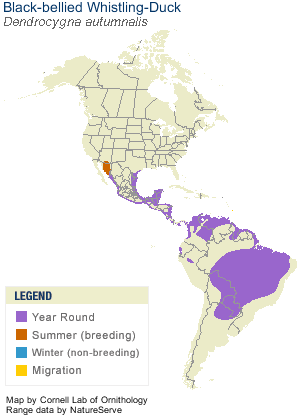
A beautiful bird, and very approachable. The duck landed at a small pond behind the
Rio & Washingtonian Center in Gaithersburg, MD. The pond is already home to at least 50 tame Canada Geese and Mallards, and the BBWD seems to enjoy very much the relaxed atmosphere of the pond, as well as the frequent feedings from kids with bread or popcorn.
Actually, many birders have raised the question of whether or not the duck seems a little too comfortable. There is an issue as to whether or not the bird is an escapee from a local breeder or zoo. Since there are no leg bands or clipped wings, the focus of the detective work on this bird has fallen on the nails of the back toes. Cutting the toenails or part of the back toe off a bird to mark it as captive is a common occurrence, and the Rio bird does not appear to have any toenails on its hind toes. Here's a picture I took this morning:
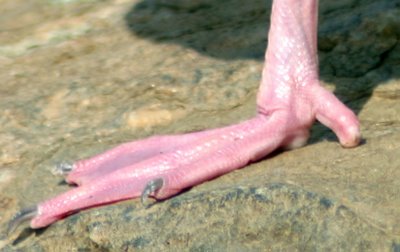
Now, just because this bird doesn't have toenails does not necessarily mean that it's an escapee. There is discussion (without resolution as of yet) that female BBWD have very small, colorless nails. Additionally, some birders see the Rio bird as having 'nubs' which may be caused from the wear of standing on rocks all day.
The most important piece of evidence to support this bird being wild (and therefore countable under ABA rules) is a flock of 12 BBWDs that appeared on a farm in Suffolk, VA yesterday. This occurrence, which is just as rare as a single bird in Maryland, could mean that we are in the middle of an irruption. Whatever the case, it's a beautiful bird and one that is very rarely found in this part of the world. If you are reading this and haven't had a chance to see the bird, to do before he catches another storm and ends up in Alaska.
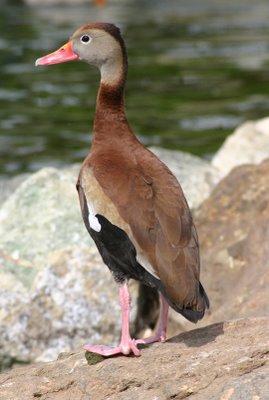
Henslow's and Grasshopper Sparrows in Maryland
I woke up early (for me) this morning and headed down to Huntley Meadows to see if the Wilson's Phalarope that was reported there yesterday was still around. I had debated whether or not to go down yesterday, but I was lazy and just went across the river and looked at a windy, empty Kenilworth Park. Bad decision. The phalarope was gone and I was an idiot.
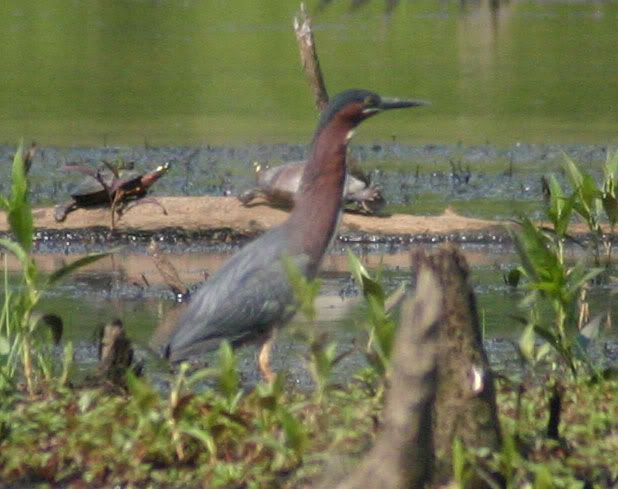
There were a few good birds...a handful of green herons, great egrets, dunlin and acadian flycatchers, but I was upset with myself for missing a good bird on account of laziness. I must redeem myself! I thought of Steve Sanford's post from Friday about Henslow's and Grasshopper Sparrows in western Maryland. It was at least a 3 hour drive each way. And gas is 3 dollars a gallon and I'm an intern. Screw it. Redemption!
The beautiful Virginia/WVirginia/Maryland countryside made the drive go by quickly, and I was soon cruising through the lovely town of Cumberland, MD and sliding off exit 33. Using Mr. Sanford's directions I easily found my way to the top of a grassy hill and started down the jeep trail (ignoring, cautiously, the NO TRESSPASSING signs, as per Mr. Sanford's advice). Immediately I could hear the metallic clinks of Grasshopper Sparrows on either side of me. Although they sounded like they were chirping right under my feet I couldn't seem them in the knee-high grass. After a couple minutes with no sightings, I started down to the flat meadow to look for Henslow's.
A little background, when I worked for the NY DEC this past summer there was talk that I might be able to go help out with a Henslow's project in one of the state forests that had a meadow. This particular state forest (I can't remember the name) wanted to get an accurate count of Henslow's to help dictate their conservation policy. Anyway, I did a bunch of research and got myself all physched up to find Henslow's, but the project never materialized. Since then seeing a Henslow's has been at the top of my wish list.
At the bottom of the hill and after taking a right into another jeep trail I was rewarded almost immediately with the quick chirp of the Henslow's Sparrow. I had listened to Peterson CD's on the way up and the noise coming from the grass at my feet was identical to the cd track. Perfect. Only problem was that, like the grasshoppers, these birds were staying in the tall grass. I waited around for about 20 minutes before I finally got a glimpse of a dark sparrow through the reeds. Through the binoculars there was no question that it was a Henslow's: big, flat head, thin breast streaks, yellow on the side of the face. I looked for a few moments, but when I looked away to try to move closer and get my camera the bird was gone. Still, I was happy.

I waited for another 20 minutes but the sparrows didn't show themselves or make a sounds. No worries. Already satisfied, I walked up back up the hill and into a pack of suddenly active Grasshopper Sparrows. There were three chasing each other around and perching on shrubs and in the path. I got a few pictures before the rain started. After a couple of misses lately (red knots and 2 wilson's phalarope attempts), it was great to find the birds I was looking for. The drive back to DC went by much quicker.
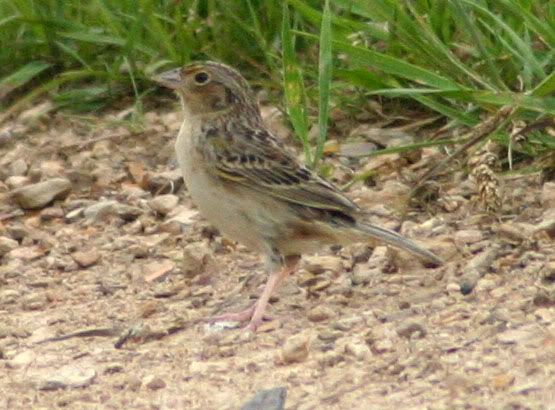
District Patrol 6/3/06
The spring migration has come and gone. While a trip to Kenilworth Park a month ago would have yielded warbler after warbler, a trip there now (like the one I just took) brings a couple of buntings, some swifts and a whole lotta not-much-else. All in all I had a pretty good spring. I missed a lot of warblers that others got, but most of them are year-round residents of the DC area (hooded, prothontary, black-and-white etc) so I'll be able to find them as the summer goes on.
Though things have slowed down a bit, there are still a ton of birds in the DC area. Let's go over some of the highlights:
Wilson's Phalarope and Little Blue Herons, Huntley Meadows
I had a chance to see Wilson's Phalaropes in Bombay Hook last weekend but I couldn't find them. Now it looks like they're coming to me.
Wilson's Phalaropes are rare in the east and, according to the linked Audubon page, have suffered a striking decline in numbers in recent years. I think I'll be out looking for this bird tomorrow.
Henslow's Sparrows, Allegany County, MD
Allegany County is about
2.5 hours from DC, but it may be worth the drive for one of the east's most secretive sparrows, the
Henslow's Sparrow. Here are local birder Mr. Steve Sanford's directions to the Henslow's:
"Old Legislative Road is in western Allegany County, just short of
Garrett County. The Henslow's spot is only about 5 minutes from I-68.
From I-68 on the west side of the Frostburg area take exit 33 south to
"Midlothian Rd." Follow the main road south about 2.5 miles. It
becomes Old Legislative Road somewhere. Cross Klondike Rd (where there
is/was a bar on the left). About 100 yards beyond the intersection
there is a big grassy hill on the left (east) side of Old Legislative
Road. (There is a side-road to the right with a gate.) The Henslow's
should be within one or two hundred yards of the left side of the
road, probably around the crest of the hill. Normally there is a
vehicle track up the hill. Listen for the "see-lick" notes of the
Henslow's. They often perch on weeds and sing. A scope helps if you
want good views, but is not crucial. There are also lots of
Grasshopper Sparrows around too, but their buzzy and tinkly notes are
completely different."
If I wake up feeling feisty I just might trek out to take a look for this bird, one that I wanted to see all last summer but wasn't able to. I'll keep you posted.













